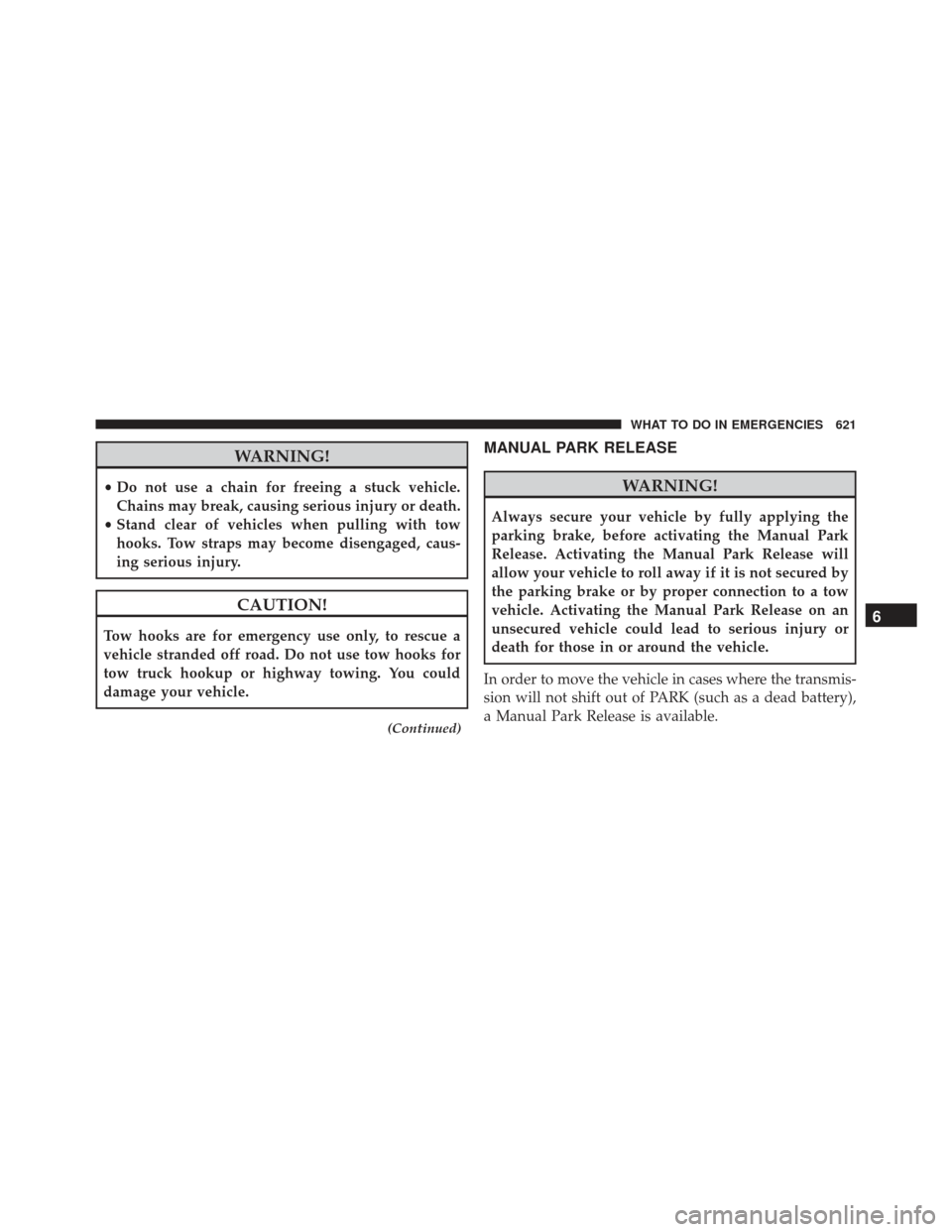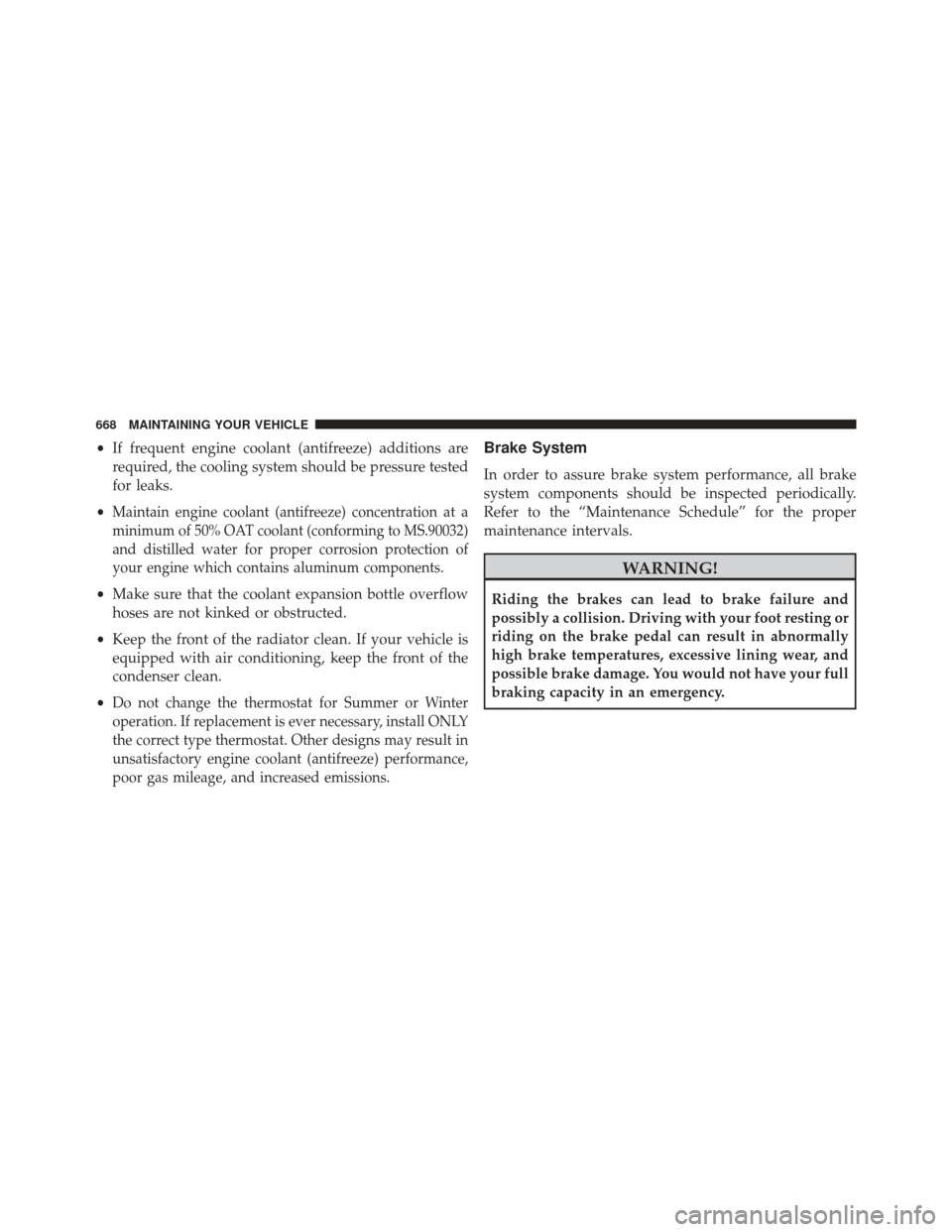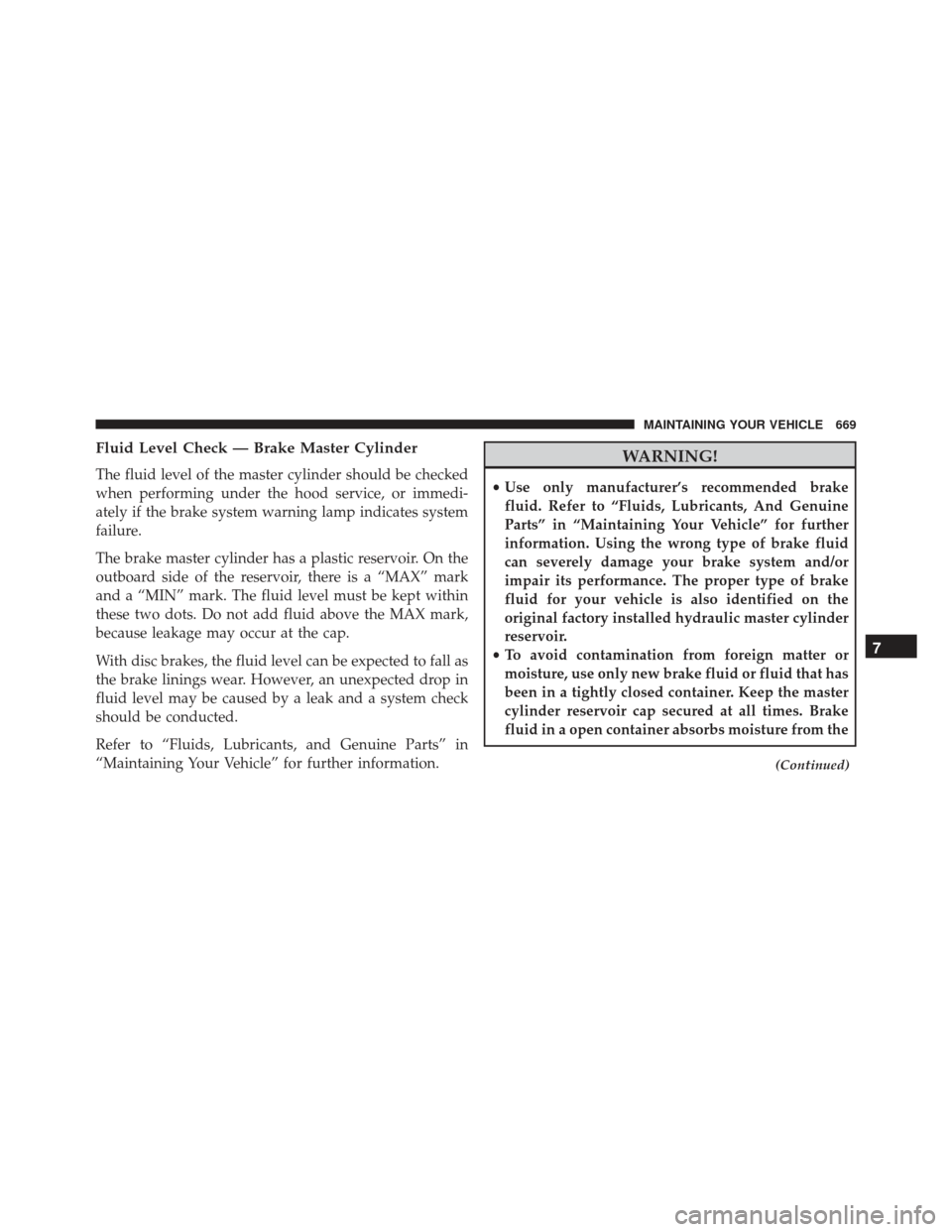Page 623 of 745

WARNING!
•Do not use a chain for freeing a stuck vehicle.
Chains may break, causing serious injury or death.
• Stand clear of vehicles when pulling with tow
hooks. Tow straps may become disengaged, caus-
ing serious injury.
CAUTION!
Tow hooks are for emergency use only, to rescue a
vehicle stranded off road. Do not use tow hooks for
tow truck hookup or highway towing. You could
damage your vehicle.
(Continued)
MANUAL PARK RELEASE
WARNING!
Always secure your vehicle by fully applying the
parking brake, before activating the Manual Park
Release. Activating the Manual Park Release will
allow your vehicle to roll away if it is not secured by
the parking brake or by proper connection to a tow
vehicle. Activating the Manual Park Release on an
unsecured vehicle could lead to serious injury or
death for those in or around the vehicle.
In order to move the vehicle in cases where the transmis-
sion will not shift out of PARK (such as a dead battery),
a Manual Park Release is available.
6
WHAT TO DO IN EMERGENCIES 621
Page 624 of 745
Follow these steps to use the Manual Park Release:
1. Firmly apply the parking brake.
2. Open the center console and locate the Manual ParkRelease cover, remove it by snapping the cover away
from the console hinges. 3. Using a screwdriver or similar tool, push the metal
latch in towards the tether strap.
Manual Park Release Cover
Release Latch
622 WHAT TO DO IN EMERGENCIES
Page 625 of 745
4. While the metal latch is in the open position, simulta-neously pull upwards on the tether strap until the
lever clicks and latches in the released position. The
transmission is now out of PARK and the vehicle can
be moved.CAUTION!
Closing the armrest while the Manual Park Release is
activated may damage the Manual Park Release
mechanism, the transmission, and/or the armrest.
NOTE: To prevent the vehicle from rolling unintention-
ally, firmly apply the parking brake.
Released Position
6
WHAT TO DO IN EMERGENCIES 623
Page 632 of 745

▫Brake System ....................... .668
▫ Front/Rear Axle Fluid ..................670
▫ Transfer Case ....................... .671
▫ Automatic Transmission ................672
▫ Appearance Care And Protection From
Corrosion .......................... .674
� FUSES ............................. .680
▫ Power Distribution Center ...............681
� VEHICLE STORAGE ....................689
� REPLACEMENT BULBS .................690
� BULB REPLACEMENT ..................691
▫ High Intensity Discharge Headlamps (HID) —
If Equipped ........................ .692▫
Halogen Headlamps — If Equipped ........692
▫ Front Turn Signal .....................693
▫ Front Fog Lamps .....................693
▫ Rear Tail, Stop, and Turn Signal Lamps ......694
▫ Rear Liftgate Mounted Tail Lamp ..........695
▫ Center High-Mounted Stop Lamp (CHMSL) . .697
▫ Rear License Lamp ....................697
� FLUID CAPACITIES ....................698
� FLUIDS, LUBRICANTS, AND GENUINE
PARTS ............................. .699
▫ Engine ............................ .699
▫ Chassis ........................... .701
630 MAINTAINING YOUR VEHICLE
Page 633 of 745
ENGINE COMPARTMENT — 3.6L
1 — Remote Jump Start Positive Terminal6 — Engine Oil Fill
2 — Engine Oil Dipstick 7 — Brake Fluid Reservoir
3 — Power Distribution Center (Fuses) 8 — Air Cleaner Filter
4 — Coolant Pressure Cap (Reservoir) 9 — Washer Fluid Reservoir
5 — Remote Jump Start Negative Terminal
7
MAINTAINING YOUR VEHICLE 631
Page 634 of 745
ENGINE COMPARTMENT — 5.7L
1 — Remote Jump Start Positive Terminal6 — Engine Coolant Reservoir
2 — Engine Oil Dipstick 7 — Engine Oil Fill
3 — Power Distribution Center (Fuses) 8 — Brake Fluid Reservoir
4 — Coolant Pressure Cap (Radiator) 9 — Air Cleaner Filter
5 — Remote Jump Start Negative Terminal 10— Washer Fluid Reservoir
632 MAINTAINING YOUR VEHICLE
Page 670 of 745

•If frequent engine coolant (antifreeze) additions are
required, the cooling system should be pressure tested
for leaks.
•
Maintain engine coolant (antifreeze) concentration at a
minimum of 50% OAT coolant (conforming to MS.90032)
and distilled water for proper corrosion protection of
your engine which contains aluminum components.
• Make sure that the coolant expansion bottle overflow
hoses are not kinked or obstructed.
• Keep the front of the radiator clean. If your vehicle is
equipped with air conditioning, keep the front of the
condenser clean.
•
Do not change the thermostat for Summer or Winter
operation. If replacement is ever necessary, install ONLY
the correct type thermostat. Other designs may result in
unsatisfactory engine coolant (antifreeze) performance,
poor gas mileage, and increased emissions.
Brake System
In order to assure brake system performance, all brake
system components should be inspected periodically.
Refer to the “Maintenance Schedule” for the proper
maintenance intervals.
WARNING!
Riding the brakes can lead to brake failure and
possibly a collision. Driving with your foot resting or
riding on the brake pedal can result in abnormally
high brake temperatures, excessive lining wear, and
possible brake damage. You would not have your full
braking capacity in an emergency.
668 MAINTAINING YOUR VEHICLE
Page 671 of 745

Fluid Level Check — Brake Master Cylinder
The fluid level of the master cylinder should be checked
when performing under the hood service, or immedi-
ately if the brake system warning lamp indicates system
failure.
The brake master cylinder has a plastic reservoir. On the
outboard side of the reservoir, there is a “MAX” mark
and a “MIN” mark. The fluid level must be kept within
these two dots. Do not add fluid above the MAX mark,
because leakage may occur at the cap.
With disc brakes, the fluid level can be expected to fall as
the brake linings wear. However, an unexpected drop in
fluid level may be caused by a leak and a system check
should be conducted.
Refer to “Fluids, Lubricants, and Genuine Parts” in
“Maintaining Your Vehicle” for further information.
WARNING!
•Use only manufacturer’s recommended brake
fluid. Refer to “Fluids, Lubricants, And Genuine
Parts” in “Maintaining Your Vehicle” for further
information. Using the wrong type of brake fluid
can severely damage your brake system and/or
impair its performance. The proper type of brake
fluid for your vehicle is also identified on the
original factory installed hydraulic master cylinder
reservoir.
• To avoid contamination from foreign matter or
moisture, use only new brake fluid or fluid that has
been in a tightly closed container. Keep the master
cylinder reservoir cap secured at all times. Brake
fluid in a open container absorbs moisture from the
(Continued)
7
MAINTAINING YOUR VEHICLE 669